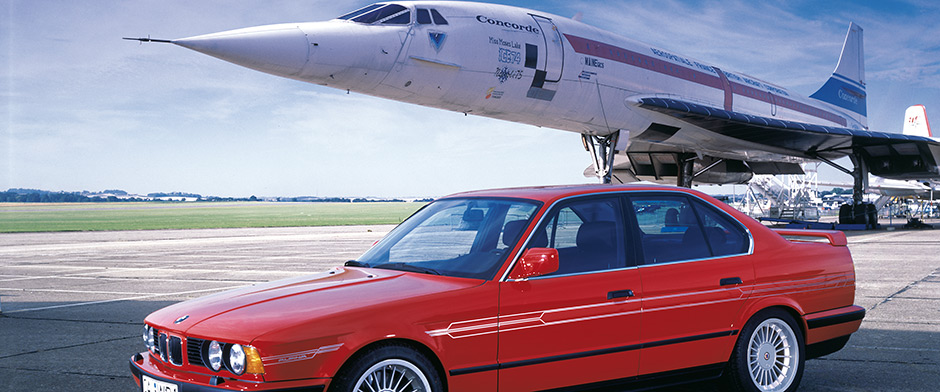ALPINA News
30th Anniversary
It is no coincidence that the BMW ALPINA B10 Bi-Turbo was featured under the fastest aircraft in civil aviation, the CONCORDE. In 1989, the CONCORDE set the standard in the air and the BMW ALPINA B10 Bi-Turbo defined the standard on the road. Together, they constitute the iconic image of cutting-edge mobility at that time.
The declared development goal of the BMW ALPINA B10 Bi-Turbo: to combine smooth power delivery, effortlessness, comfort, safety and performance in a manner that had not existed previously in the exclusive and small segment of the world’s finest and fastest automobiles. And the ALPINA engineers delivered on their promise: when the BMW ALPINA B10 Bi-Turbo was presented at the Geneva Motor Show 30 years ago, both trade press and automobile connoisseurs from around the world were equally enthusiastic. Two GARRETT T25 turbochargers and an electronic boost pressure control - a novelty!
What makes the ALPINA 3.5 litre Bi-Turbo engine so special is that the boost pressure is delivered almost instantaneously, there is practically no turbo lag and no overboost effect as was the case with earlier mechanical-pneumatic boost pressure controls. The straight-six engine impresses with its smooth running characteristics and dynamic, almost unlimited power delivery. The power build-up is gentle and linear but forceful nonetheless. The Bi-Turbo charging system set a completely new benchmark for enthusiast drivers who value the BMW ALPINA B10 Bi-Turbo for its comfortable sportiness and elegance to this very day. The advertising claim at the time was for once true to reality: “One of the most sophisticated among the really fast cars of the world. One of the fastest among the really sophisticated cars of the world.”
Speaking of speed: with its impressive 360 hp and a generous torque of 520 Nm (383 lbs-ft), the Bi-Turbo engine pushes this model to an incredible top speed of 291 km/h (180 mph). This makes the BMW ALPINA B10 Bi-Turbo the most powerful and fastest production saloon of its time. It accelerates from 0 to 100 km/h in just 6.3 seconds, and is therefore still competitive today.
Between 1989 and 1994, a total of 507 units of the BMW ALPINA B10 Bi-Turbo left the manufactory in Buchloe, each with a numbered ALPINA production plaque. Today, the first BMW ALPINA B10 Bi-Turbo models can claim to be classic cars. Congratulations on the H plate (German number plate classification for classic cars older than 30 years) to the most recent members of the ALPINA classic car family!
Limited anniversary offer: On the occasion of the 30th anniversary, we are reissuing the BMW ALPINA B10 Bi-Turbo model badging in form of a key chain. The top speed of the Bi-Turbo was 291 km/h – which is also the number of limited key chains available in the ALPINA Lifestyle Shop.
